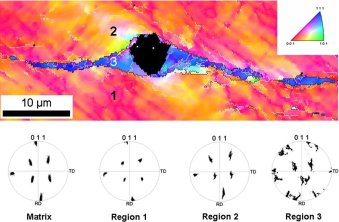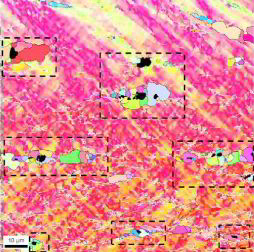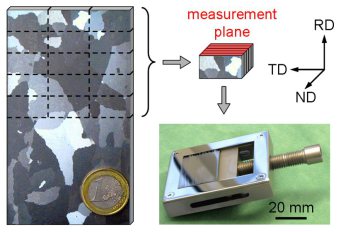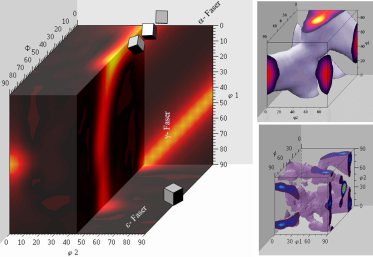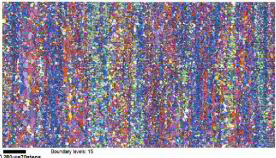Crystallographic textures of metallic alloys
What are crystallographic textures of steels and why do they matter?
The casting, rolling and recrystallization textures of the different types of bcc steels often show great similarities, but also exhibit characteristic differences which, e.g. depend upon starting texture, microstructure and condition of precipitations. In this paper this behaviour will be discussed for three examples belonging to three entirely different types of steels.
More specific, the rolling and recrystallization texture development of bcc steels is discussed for three examples belonging to three different types of steels, namely deep drawing steels (e.g. low carbon steel), ferritic stainless steels (e.g. Fe16%Cr) and electrical steels (e.g. Fe3%Si).
ADVANCED ENGINEERING MATERIALS 2003, 5, No. 7
Thomas et al - Adv Eng Materials 2003 IF[...]
PDF-Dokument [288.2 KB]
Electrical steels (e.g, Fe3%Si transformer steels): For the use of these steels in transformers high magnetic permeability for magnetization in rolling direction is required which can be obtained by a <100> direction parallel to the rolling direction. Technologically this can be achieved by forming a very sharp Goss texture {011}<100> by secondary recrystallization.
Deep-drawing steels (e.g, low-carbon steel): Here the most important property is a good deformability in deep drawing. This behaviour is favoured by a texture formed in such a way that during deep drawing the material flow occurs from the width and not from the thickness of the sheet and that it is equal for different directions in the sheet plane, i.e. by materials with the high r-value and a low Delta- r value (r is the Lankfort parameter). Both properties can be achieved by a texture which after recrystallization consists of a homogeneous strong fibre texture with a {111} plane parallel to the sheet plane.
Martin Holscher, Dierk Raabe and Kurt Lucke
steel research 62 (1991) No. 12, p 567
steel research 62 (1991) 567 Overview ro[...]
PDF-Dokument [748.4 KB]
Ferritic stainless steels (e.g. Fe16%Cr): Here again the requirements for deep drawability should be fulfilled, but additionally the ridging which often occurs in Cr-steels should be suppressed. This again means a {111} fibre texture but also a topologically random arrangement of crystallites should be achieved).
steel research int. 76 (2005) ridging st[...]
PDF-Dokument [1.7 MB]
Modelling Simul. Mater. Sci. Eng. 18 (2010) 085005
B Liu, D Raabe, F Roters, P Eisenlohr and R A Lebensohn
Comparison of finite element and fast Fourier transform crystal plasticity solvers for texture prediction
Modelling Simul. Mater. Sci. Eng. 18 (20[...]
PDF-Dokument [3.1 MB]
Deformation texture modeling started with the Taylor full-constraints model (1938) [1] using the simplest approximation of equal strain partitioning in a grain aggregate. Owing to this stiff iso-strain formulation and the strong discrepancy between experiments and corresponding predictions this approach was later modified via a global relaxation approximation of some of
these strain constraints [2, 3] leading to the relaxed-constraints Taylor models. Later variants, which can be referred to as grain-cluster or grain interaction models, considered local
grain neighborhood relaxations such asVan Houtte’s 2-grain-clusterLAMELmodel and the modified LAMEL model (ALAMEL model) [4, 5], a grain relaxation model proposed by Evers et al
[6], and the 8-grain-interaction GIA model of Gottstein and co-workers [7, 8]. Other models cast the mean-field homogenization problem in the form of an ellipsoidal inclusion in an
infinite matrix as originally suggested for elastic materials by Eshelby [9].
An extension of this approach to nonlinear constitutive response was suggested by Hill [10]. Molinari et al [11] and Lebensohn and Tom´e [12] later proposed a self-consistent
integral formalism which links effective and grain average stresses and strain rates. The first full-field crystal plasticity calculations were performed by Peirce et al in 1982
[13] using a 2D crystal plasticity finite element method (CPFEM) simulation. The term ‘fullfield’
indicates that both long-range and short-range grain interactions are considered, and the micromechanical fields resolved on a discrete grid. In the CPFEM case a variational solution is
achieved for the equilibrium of the forces and the compatibility of the displacements using the principle of virtual work for a volume that is discretized into finite elements. The
essential step which renders the deformation kinematics of this approach a crystal plasticity formulation is the fact that the velocity gradient is written in dyadic form (i.e. in terms of
the sum of the contributions of the different active slip systems). This reflects the tensorial crystallographic nature of the underlying defects that lead to shear and consequently, to
both shape changes (symmetric part) and lattice rotations (skew-symmetric part). These simulations were later extended to a polycrystalline arrangement by Harren et al [14, 15] using a 2D
set-up with two
or three slip systems. Becker performed simulations on the basis of the 12 slip systems of the face-centered cubic (FCC) crystal structure. Using a 3Dmodel for the crystallographic
degrees of freedom he calculated channel-die deformation of a columnar polycrystal aggregate [16] and of a single crystal [17]. Since then, CPFEM methods became increasingly popular,
particularly to tackle sub-grain scale problems, using meshes with sub-grain resolutions and, in occasions,
complex 2D and 3D grain arrangements [18–25]. Following the pioneering work of Suquet and co-workers [26, 27] for linear and nonlinear composites, Lebensohn [28] introduced an alternative
full-field crystal plasticity formulation
by applying a FFT-based algorithm in conjunction with Green’s function method, to solve the governing equations for heterogeneous media (e.g. see Mura [29]). This approximation solves the
equilibrium equations under the constraint of strain compatibility for materials with periodic microstructure, which can be generated by periodic repetition of a unit cell. This full-field
crystal plasticity fast Fourier transform (CPFFT) approach provides an alternative to
the CPFEM model with periodic boundary conditions [30]. In general, for the same spatial resolution, the CPFFT approach is a very efficient alternative compared with CPFEM with periodic
boundary conditions. This higher numerical performance of CPFFT is related to the repetitive use of the efficient FFT algorithm, avoiding the time-consuming inversion of large matrices,
needed under CPFEM. Although the exact reduction in computation time that it is obtained using CPFFT instead of CPFEM is obviously problem-dependent, it is typically from one to several
orders of magnitude [30]. The aim of this work is to analyze and compare the predictions of the CPFFT and CPFEM
models for deformation textures of FCC polycrystals. We simulate the rolling texture evolution of a 1024-grain representative volume element (RVE) representing an AA1200
aluminum polycrystal under plane-strain boundary conditions (i.e. an approximation of a rolling process) using the CPFFT and the CPFEM models. To further understand the different
predictions of both models, the correlation between grain rotations and strain gradients is next investigated
through the simulation of plane-strain compression of bicrystals at different discretization levels. Finally, a study of the influence of the initial crystal orientation and the
crystallographic neighborhood on grain rotations and grain subdivisions is carried out by means of plane-strain compression simulations of a 64-grain RVE with four important orientation
components clustered in random order.
In this paper we compare two full-field formulations, i.e. a crystal plasticity fast Fourier transform-based (CPFFT) model and the crystal plasticity finite element model (CPFEM) in terms of the deformation textures predicted by both approaches. Plane-strain compression of a 1024-grain ensemble is simulated with CPFFT and CPFEM to assess the models in terms of their predictions of texture evolution for engineering applications. Different combinations of final textures and strain distributions are obtained with theCPFFTandCPFEMmodels for this 1024-grain polycrystal. To further understand these different predictions, the correlation between grain rotations and strain gradients is investigated through the simulation of plane-strain compression of bicrystals. Finally, a study of the influence of the initial crystal orientation and the crystallographic neighborhood on grain rotations and grain subdivisions is carried out by means of plane-strain compression simulations of a 64-grain cluster.
D. Raabe, Z. Zhao, F. Roters
Scripta Materialia 50 (2004) 1085–1090
Scripta Mater vol 50 (2004) 1085 stabili[...]
PDF-Dokument [530.7 KB]
Cube-oriented face centered cubic (FCC) crystals exhibit the evolution of heterogeneous in-grain crystallographic microtextures and deformation structures during plane strain
compression [1–15]. Cube-oriented FCC crystals are metastable under plane strain, i.e. upon loading they can show lattice rotations about the normal direction (ND), the rolling
direction (RD), or transverse direction (TD) depending on the initial orientation spread prior to loading and on the mechanical boundary conditions. Many experiments have
documented the dependence and the sensitivity of the microtexture and microstructure evolution in cube crystals on the deformation conditions [1–15]. In these studies it was observed
that due to the kinematical metastability of the cube orientation small changes in boundary conditions may entail significant changes in microstructure and texture. Various models
were suggested to predict the microtextures of cube-oriented FCC crystals during deformation
which, however, in part contradict each other. For example, early models for in-grain lattice rotations about ND and RD were suggested by Dillamore and Katoh [16] as well as by Lee et
al. [17]. Other models favoring rotations about TD were later suggested by the groups of Hansen [7] and Driver [11].
From this concise introduction to the field we can extract two main aspects of microtexture evolution in cube-oriented grains. First, no model has been able so far to cover all
experimental observations of lattice re-orientations made by the various groups [1–15]. In particular, it is unclear whether the intrinsic re-orientation tendency of cube crystals
under plane strain loading leads to rotations about TD, ND, or RD. Second, the behavior of single cube crystals under plane strain loads is obviously sensitive to the mechanical
boundary conditions. Both aspects imply that a refined model which aims at explaining these observations must be sufficiently sensitive with respect to small variations in starting
and boundary conditions (e.g. initial small texture variation within the cube grain or changes in friction). We study orientational grain fragmentation of cube-oriented FCC crystals by using a texture component based crystal
plasticity finite element method. We describe the starting texture of the crystals in terms of a spherical Gaussian. Orientational in-grain heterogeneity occurring during loading is
investigated as a function of friction and orientation scatter.
Acta Materialia 50 (2002) 4379–4394
On the dependence of in-grain subdivision and deformation texture of aluminum on grain interaction
D. Raabe, Z. Zhao, W. Mao
Acta Materialia 50 (2002) 4379–4394 crys[...]
PDF-Dokument [271.1 KB]
We present plane strain simulations about the dependence of orientational in-grain subdivision and crystallographic deformation textures in aluminum polycrystals on grain interaction. The
predictions are compared to experiments. For the simulations we use a crystal plasticity finite element and different polycrystal homogenization models. One set of finite element
simulations is conducted by statistically varying the arrangement of the grains in a polycrystal. Each grain contains 8 integration points and has different neighbor grains in each simulation.
The reorientation paths of the 8 integration points in each grain are sampled for the different polycrystal arrangements. For quantifying the influence of the grain neighborhood on
subdivision and texture we use a mean orientation concept for the calculation of the orientation spread among the 8 originally identical in-grain orientation points after plastic straining. The
results are compared to Taylor–Bishop–Hill-type and Sachs-type models which consider grain interaction on a statistical basis. The study reveals five important points about grain
interaction. First, the consideration of local grain neighborhood has a significant influence on the reorientation of a grain (up to 20% in terms of its end orientation and its
orientation density), but its own initial orientation is more important for its reorientation behavior than its grain neighborhood. Second, the sharpness of the deformation texture is
affected by grain interaction leading to an overall weaker texture when compared to results obtained without interaction. Third, the in-grain subdivision of formerly homogeneous
grains occurring during straining is strongly dependent on their initial orientation. For instance some crystals build up in-grain orientation changes of more than 20° after 95% straining
while others do practically not subdivide. Fourth, the dependence of in-grain subdivision on the neighbor grains is different for crystals with different initial orientation (cube or
rotated Goss grains reveal strong subdivision). Fifth, the upper bound for the variation of texture due to changes in grain neighborhood amounts at most to 5% in terms of the positions of the
main texture components. In terms of the
overall orientation density all predictions (using different neighborhood configurations) remain within a narrow tube with an orientation scatter of 10% (β-fiber) to 20% (Brass component,
α-fiber)) when the neighborhood changes.
A Texture Evolution Study Using The Texture Component Crystal Plasticity FEM
Franz Roters, Heyon. Jeon-Haurand and Dierk Raabe
Materials Science Forum Vols. 495-497 (2005) pp. 937-943
Materials Science Forum Vols. 495-497 (2[...]
PDF-Dokument [236.0 KB]
Crystal plasticity FEM simulations of plane strain compression were performed. The Texture Component Crystal Plasticity-FEM was used for the texture mapping. Two different starting textures (random and hot rolling texture) were studied using four different FE meshes and two different sets of boundary conditions. While for the random starting texture the evolution of the texture with deformation was found to be rather similar in all cases studied, the simulations using an experimental hot rolling texture as staring texture are much more sensitive to the boundary conditions and probably also to changes in the mesh geometry.
Acta metall. mater. Vol. 43, No.3, pp. 1023-1028, 1995
Acta metall. mater. Vol. 43, No.3, pp. 1[...]
PDF-Dokument [395.1 KB]
The hot rolling textures of aluminium are simulated by means of a Taylor type model which takes into consideration dislocation slip on {111 }(110) and {110}(110) glide systems and the interaction of grains. For the investigation of the stability of the cube component during hot rolling various ratios of the corresponding critical resolved shear stresses tau{110}/tau{111} are applied. Whereas the orientation densities and the positions of the p-fibre components {112}<111I) and {123}(634) are not substantially influenced by slip on {110}<110) glide systems the cube component is developed at the expense of the {110}<112) orientation when the yield surface for {110} slip is within that for {111} slip.
The cube component {001 } (100) is the dominant recrystallization component of the crystallographic texture in strongly cold rolled and subsequently annealed face centered cubic (f.c.c.) materials with high and medium stacking fault energy. The origin of grains with this orientation has been the subject of thorough investigations in the past. By examination of the local texture by means of transmission electron microscopy and analysis of electron back scattering patterns in the scanning electron microscope it was revealed that elongated cube-oriented zones occur in the microstructure of cold rolled copper and aluminium. These cube-oriented ribbon-like zones, which have been interpreted
as transition bands are supposed to act as nuclei during subsequent recrystallization, Whereas special attention has thus been drawn to the explanation of the formation of cube
oriented zones in cold rolled aluminium, the evolution of cube-oriented grains during hot rolling has often been neglected. According to slip traces which were found in hot rolled
aluminium the activation
of dislocation slip not only on {111}(110) slip systems but additionally on {110}(110) systems must be taken into account for homologous rolling temperatures above 0.6. Recently the
stability of cube-oriented grains during hot rolling of
aluminium has therefore been inspected by use of Taylor simulations considering slip on all potential slip systems and by experimental investigation of hot rolled aluminium single
crystals with initial {001}(100) and {001}<110) orientations.
steel research vol 74 2003 overview roll[...]
PDF-Dokument [2.6 MB]
This report gives a review on basic types of crystallographic textures developing during hot rolling ot steels. The results are grouped into three fundamental classes of textures
METALLURGICAL AND MATERIALS TRANSACTIONS A VOLUME 28A, NOVEMBER 1997, page 2343
Modeling-ferritic-chromium-stainless-ste[...]
PDF-Dokument [588.5 KB]
Modeling of texture development has great technological importance, as plastic deformation usually induces strong anisotropies in polycrystalline metals, leading to directional dependencies of the physical properties. The behavior of an individual crystal, however, depends on its interaction with its surroundings, which is difficult to account for. Early models (Sachs and Taylor) assumed stress and strain homogeneity, respectively. However, these idealized conditions were not perfectly verified by measurements or simulation results. It was recognized that grain shape effects can be important, and were first taken into account by the relaxation of some stress components (relaxed-constraints model). These relaxations, however, can only be justified when the grain shapes are far from equiaxed, i.e., are normally at very large strains (except when they are elongated already at the beginning of deformation, a case that will be studied in the present work). An important step was taken with the introduction of the
self-consistent models, which consider a grain as an inclusion embedded in the polycrystal. A grain’s surroundings is a homogeneous equivalent medium (HEM) in these models, which is defined by the average physical properties of all grains. This approach can naturally account for the shape and its evolution during deformation. It introduces an interaction law between a grain and the polycrystal, for which several approaches were proposed, namely, secant, tangent, and finite-element-tuned models. Among these, the one that has been calibrated with the help of some finite-element calculations will be employed in the present study. This modified self-consistent model has already
been successfully tested for torsion and rolling. For completeness and in order to estimate the performance of the self-consistent model, the classical Taylor and
relaxed- constraint approaches will also be considered. All models employed in the present work use the well-known viscoplastic power law for crystallographic slip,
incorporating microscopic strain hardening of the slip systems. The cold-rolling textures of a ferritic chromium sheet steel containing 11 pct Cr are studied in the present
work. Before cold rolling, it contained already very elongated
grains in its middle section, where the textures were measured and also simulated. Important effects of grain shape and hardening were found, which have been studied by the Taylor, the
relaxed-constraints pancake, and the self-consistent viscoplastic models.
The development of crystallographic texture during rolling of a ferritic chromium steel containing 11 pct Cr was examined experimentally as well as by polycrystal modeling at large strains (up to 90 pct thickness reduction). The initial shape of the grains was very much elongated in the direction of rolling. A strong rolling direction (RD) fiber (110 parallel to the rolling direction) has been observed at large strains in the experiment. The Taylor viscoplastic model, the relaxed-constraints pancake model, and the self-consistent viscoplastic approach were employed to simulate the texture development. Strain hardening was accounted for by microscopic hardening laws, for which the parameters were obtained from uniaxial tensile tests. It has been found that among the three models considered, the self-consistent viscoplastic model (the version tuned to finite-element results) yielded the best agreement with the experimentally observed texture evolution. Strong effects of grain shape and hardening have been found. The pancake model was also able to reproduce the main characteristics of the texture because of the flattened initial grain shape.
Non-crystallographic shear banding in crystal plasticity FEM simulations: Example of texture evolution in alpha-brass
Acta Materialia 60 (2012) 1099-1115
N. Jia, F. Roters, P. Eisenlohr, C. Kords, D. Raabe
Acta Materialia 60 (2012) 1099 Shear ban[...]
PDF-Dokument [849.1 KB]
We present crystal plasticity finite element simulations of the texture evolution in a-brass polycrystals under plane strain compression. The novelty is a non-crystallographic shear band
mechanism [Anand L, Su C. J Mech Phys Solids 2005;53:1362] that is incorporated into the constitutive model in addition to dislocation and twinning. Non-crystallographic deformation associated
with shear banding leads to weaker copper and S texture components and to a stronger brass texture compared to simulations enabling slip and twinning only. The
lattice rotation rates are reduced when shear banding occurs. This effect leads to a weaker copper component. Also, the initiation of shear banding promotes brass-type components. In summary the
occurrence of non-crystallographic deformation through shear bands shifts face-centered-cubic deformation textures from the copper type to the brass type.
Materials Science and Engineering A 488 (2008) 482-490
Simulation of earing of a 17% Cr stainless steel considering texture gradients
I. Tikhovskiy, D. Raabe, F. Roters
Mater Sc Engin A 488 (2008) 482 Crystal [...]
PDF-Dokument [1.5 MB]
A texture component crystal plasticity finite element method (TCCP-FEM) is used for the simulation of cup drawing of a ferritic stainless steel sheet (X6Cr17, AISI 430, EN 1.4016). The simulation includes the through-thickness texture gradient of the starting hot band. It predicts the development of the orientation distribution and the earing profile during cup forming considering 48 slip systems ( 12 {110}<111>, 12 {112}<111>, 24 {123}<111>, ). The earing profiles are compared to FE results obtained by use of a Hill 48 yield surface and to experimental data.

